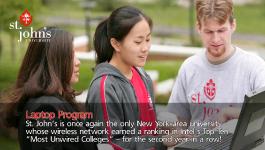StrandVision Digital Signage
715-235-SIGN (7446) | www.StrandVision.com
- Home
- News & Events
- In The News
- Lighting The Way
Lighting The Way
New services are bringing new vistas to campus.
October 2006 - By Jean Marie Angelo
 Need to direct new students to unfamiliar buildings on campus? Nothing does the trick like a map. Now imagine that map presented in color and blown up to fit on a 42-inch screen. Add to this image descriptive headlines and text and changing inset graphics that can provide close ups of the section of campus where the building is located, along with pictures of the destination, and it's clear just how effective digital signage can be.
Need to direct new students to unfamiliar buildings on campus? Nothing does the trick like a map. Now imagine that map presented in color and blown up to fit on a 42-inch screen. Add to this image descriptive headlines and text and changing inset graphics that can provide close ups of the section of campus where the building is located, along with pictures of the destination, and it's clear just how effective digital signage can be.
Digital signs started appearing on campuses a few years ago, with some promoting sales in bookstores and other retail outlets and others providing information for those passing through the student union or dining hall. In this fashion, higher ed was catching up to hotels, financial institutions, big box retailers, and other sectors that provide information to the public. Once these industries began showing how convenient it is to digitally change information and create a multimedia presentation that can grab attention much easier than paper posters and bulletin boards crammed with out-dated paper flyers, higher education administrators saw the logic in using this new technology.
It has helped that plasma and LCD flat panel screens are now more common and have come down in price. Spurring the trend, too, are new services that ease the headache of content management and planning for overworked higher ed public affairs and promotion departments.
| "Our students are into gizmos and high tech, Digital signage gives you a connection to students that you can't get with other advertising." -Charlie Salas, Texas State University |
Basically, digital signage enhances any area on campus where large groups of people pass by or congregate, says Rosemary Abowd, an analyst with Pacific Media Associates, a company that provides research on multimedia and large screen displays. (See sidebar on technology trends and pricing.)
Few people know about the technology's benefits better than Charlie Salas, associate director of the LBJ Student Union at Texas State University. He's a client of The University Network, or TUN (pronounced t-u-n), a digital signage service for colleges and universities. At TSU, 42-inch, flat panel digital signs that hang in the LBJ Student Center and the campus recreation center help promote campus activities and vendors. TUN, as well, provides national advertising aimed at students, and allows TSU to share in 20 percent of the national advertising revenue. "We receive a check for about $200 every quarter," says Salas, who adds that the impetus for installing TUN's digital signage system in 2004 was not really to make money. The real goal was to be able to more easily inform students about services and activities. Certainly, though, the revenue checks are a nice by-product of the digital signage installation.
Salas wanted to cut through the media clutter on campus and get students' attention. "Our students are into gizmos and high tech," he says. "Digital signage gives you a connection to students that you can't get with other advertising."
Texas State participates in one of two types of programs that TUN offers. While TSU takes advantage of the revenue-sharing model, the company also provides a separate service that does not share revenue, but instead, installs more digital signs on campus. The difference is one screen versus up to three per department, says Denise Stephenson, senior vice president of University Services for TUN.

In addition, TUN, which is a division of InFocus, provides creative and production services for its more than 160 higher education clients. Those who receive a portion of the national advertising revenue are guaranteed three new, 20-second spots per week, while those who have installed more screens can run up to five spots. These promotions are campus-specific.
Each week Salas and TSU staffers send TUN basic text, logos, and images related to the news and events they want to promote, and the TUN creative team does the rest. Of course, TUN can change information quickly if there is an emergency on campus.
"We can run public service announcements," explains Stephenson. Last year, the company created informational spots for campus customers affected by Hurricane Katrina. It also has created missing persons announcements.
The benefits for TUN are obvious-by signing on college and university clients they can deliver the college audience to national advertisers, such as 1-800-Flowers, The Gillette Company, Paramount Pictures, and Columbia Sportswear. But the program also helps colleges and universities that might not be able to pay the estimated $25,000 to purchase and install several flat-panel displays, nor be able to pay the additional cost to install the creative and content management software.
While Salas doesn't offer any bottom-line ROI metrics on the digital signage's effectiveness, he does have a telling anecdote. A national ad for cellphone ringtones featured a hard-to-forget-one might say obnoxious-jingle, he recalls. "People were humming that stupid song throughout the building," he says. That day he made a mental note that digital signage is definitely reaching the TSU audience.
Help on the Highway
The State University of New York has teamed up with the New York State Thruway Authority to inform travelers about the 64 colleges and universities in the SUNY system.
A series of 12 kiosks located in six Thruway Travel Plazas give curious travelers location information, but also inform about programs and degrees offered throughout the SUNY system.
The Thruway Authority built the seven-foot-tall kiosks, which each display four, four-color panels. Each panel highlights a different aspect of the SUNY system. One panel is a map that includes the location of every SUNY campus; another lists all doctoral granting institutions; one shows community colleges; and the last lists those in the region. SUNY invested $2,000 per kiosk to participate in the promotion.
Bringing the Project In House
St. John's University (N.Y.) took a different approach one year ago, when staff there decided to install digital signage. Instead of having an outside service handle the content, the team there brought it in house. St. John's signed with NEC to purchase five, 46-inch LCD digital signs, which were up and running in January, along with the creative and management software that drives the digital signage system.

To date, St. John's has spent $82,885 on its digital signage program, which its technical staff views as a larger investment in technological innovation.
"We put these in high traffic areas where students pass through the lobbies," explains Joseph J. Tufano, CIO for Information Technology at the university. Those specific areas include the University Center, the dining hall, and the library. A team of people, led largely by Joanne Novarro, director of internal and external communications, changes the creative everyday.
"This is really a challenge," Novarro admits. But an ever-flowing mix of digital media is a necessity on campus. "Students today are really savvy and we have to constantly change the content, or we will lose them."
Since installing digital signage, the team at St. John's has produced some ambitious segments. Coverage of a campus Holocaust Remembrance Day on April 25 included live broadcasts that featured survivors and their families.

The team has also altered digital signage to speak to varied audiences. For example, welcoming signage for an accepted students day-where those contemplating enrolling at St. John's were on campus-was edited to list the differing undergraduate majors offered on the Queens and Long Island campuses. Other notices and campus maps also were broadcast to help make the day easier on the newbies.
Digital signage also is used to notify students of emergencies or schedule changes, such as campus closings because of bad weather, notes Tufano. This is a strong point of the NEC system. The company recently announced a partnership with XTEND Communications Corp. to be able to push digital signage content such as emergency text messages to cellphones, e-mail clients, even PDAs. NEC is calling the service its Emergency Campus Notification Solution.
The new technology allows users to reach students and staff who might not be near a digital signage screen, or even on campus.
Cable Connections
The University of Connecticut has set its three new 42-inch Sony LCD digital signage screens in the Neag School of Education to receive cable TV feeds, says Gary Hendrickson, the school's director of technology. "There is a network on campus that carries 82 cable channels," he explains. The connection allowed students and staff to watch live coverage of the recent terrorist plot involving commercial airlines that was uncovered in London.
Of course, most coverage is not so urgent, yet important to running a smooth campus operation. Notices that welcome new education students, instructors, and visiting department lecturers are interspersed with announcements about student activities.
The web production team has the "right eyes" for creating digital signage spots.Sports news is also a popular feed, especially with many Red Sox fans on staff.
The creative is managed by a browser-based software that allows for content editing and broadcast scheduling. Janis Palmer, the school's communications director, either directly creates the material that is eventually broadcast, or reviews everything and gives a final OK.The digital signage was added when the Neag School of Education underwent a $350,000 renovation two-and-a-half years ago, explains Hendrickson.
"This was part of the planning from the beginning," he says. "We spent a lot of time looking into the future and asking: 'Where is technology going to be?'"
Like St. John's, UConn is also looking to take the logical next step, which will be to push the digital signage information to iPods, cellphones, and other individual devices. A scan of campus will show that at any given moment most students are using cellphones, PDAs, or MP3 players.
"We are looking to keep up with students; they are innovators," Hendrickson says.
Resources
- 3M, www.3Mdigitalsignage.com
- Focus Enhancements, www.focusinfo.com
- LG Electronics, www.lgcommercial.com
- NEC, www.nec.com
- Sampo Professional, www.regent-usa.com
- Sony, www.sony.com
- StrandVision, www.strandvision.com
- The University Network, www.tun.com
Pricing Trends
Most AV equipment comes to campus once there is enough choice and volume in the marketplace to bring prices down. In that sense, digital signage is following the trend set by projectors, visualizers, and other AV equipment that was originally out of reach, but is now more affordable for the education audience.
"The digital signage market has experienced price drops of 25 percent to 50 percent over the past 19 months," says Rosemary Abowd, an analyst with Pacific Media Associates, a firm that tracks digital signage and other AV trends. "These devices are becoming as affordable as a front projector." Specifically, some 42-inch digital signage panels that can be used for professional (not home) purposes are selling for under $2,000, she adds.
The average price for a high-definition plasma 42- to 43-inch display screen was $2,233 in July 2006, down from $2,810 a year earlier. The price for an LCD screen of the same size was $3,477, down from $4,574.
What I Really Want to Do Is Direct
Digital Signage systems are turning campus public relations directors and public affairs officers into media producers. Live action from the latest basketball game can be accompanied by split screens that include scores and season statistics. Audio feeds can give the play-by-play. Other projects can include broadcasting commencement ceremonies, or mixing local news with national clips.
All this takes coordination and know-how that will stretch the team more accustomed to writing press releases or articles for traditional print media, rather than deciding on close-ups and camera angles.
Those at institution's with systems in place have a few tips to offer for a smooth transition into the world of multimedia production.
But it's not just the web team that produces the digital signage spots. Sometimes students create the video clips as part of classwork; sometimes professors provide announcements. Recently, a professor was organizing a trip for students to the Galapagos Islands. He submitted some slides and Joanne Navarro, director of internal and external communications, turned the material into a usable digital signage announcement.
"I do a lot of the final approval of the content," explains Navarro, who estimates that she spends several hours per week creating and approving digital signage content.
Creative Help
As digital signage has become more popular-and more affordable for the higher ed market-a number of services have been introduced to help create signage "productions" and better schedule and manage what viewers see.
The StrandVision Digital Signage system allows media producers to easily split screens, displaying images on one side and text on the other. The program even creates a text crawl on the bottom of the screen. All three areas can receive message feeds from a campus department or from StrandVision directly. (The company can provide streaming news content, weather reports, or other programming.) The company's subscription-based software is accessed via the internet, explains Mike Strand, president and CEO. An authorized user with the correct passwords can go online and get into the system from any computer and change content. Subscription pricing begins at $54.95 per month for the first location, he adds. The company's service works with existing IT networks, along with televisions and plasma and LCD screens.
3M's digital signage division provides software to manage creative. Options range from a single "entry" point to a system that can be part of a larger LAN.
LG Electronics introduced a series of larger, 60-inch plasma screens earlier this year. They are intended for larger venues and can be hung from ceilings or walls.
Sampo Professional, a company that offers LCD and plasma monitors to education and other markets, introduced its Display Net event manager software this year. The new program allows users to schedule and monitor text, video, and other media being broadcast.
Focus Enhancements, a digital signage vendor that works with the University of Tulsa and several other IHEs, offers digital media players, and management software. The company is working with DART, a digital signage software, to help users manage media over AV/IT networks.
